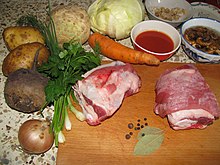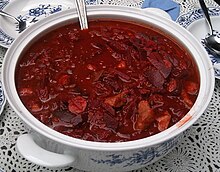"Borsch", "borshch", and "borsht" redirect here. For other uses, see Borsch (disambiguation).

A bowl of borscht garnished with dill and a dollop of smetana (sour cream)
|
|
| Alternative names | Borsch, borshch, borsht, bortsch |
|---|---|
| Type | Soup |
| Place of origin | Ukraine |
| Various East European cuisines | |
| Cooking time | 3 hours to 6 hours |
| Serving temperature | Hot or cold |
| Main ingredients | Beetroot |
| Variations | Green borscht, white borscht |
Borscht derives from an ancient soup originally cooked from pickled stems, leaves and umbels of common hogweed, a herbaceous plant growing in damp meadows, which lent the dish its Slavic name. With time, it evolved into a diverse array of tart soups, among which the beet-based red borscht has become the most popular. It is typically made by combining meat or bone stock with sautéed vegetables, which – as well as beetroots – usually include cabbage, carrots, onions, potatoes and tomatoes. Depending on the recipe, borscht may include meat or fish, or be purely vegetarian; it may be served either hot or cold; and it may range from a hearty one-pot meal to a dainty clear broth or a smooth refreshing drink. It is often served with smetana or sour cream, hard-boiled eggs and/or potatoes, but there exists an ample choice of more involved garnishes and side dishes, such as uszka or pampushky, that can be served with the soup.
Its popularity has spread throughout Eastern Europe and the former Russian Empire, and – by way of migration – to other continents. In North America, borscht is often linked with either Jews or Mennonites, the groups who first brought it there from Europe. Today, several ethnic groups claim borscht, in its variegated local guises, as their own national dish and consume it as part of ritual meals within Eastern Orthodox, Greek Catholic, Roman Catholic, and Jewish religious traditions.
Contents
Etymology
The English word borscht, also spelled borsch, borsht, or bortsch,[1] comes from Yiddish באָרשט (borsht). The latter derives from the word борщ (borshch), which is common to East Slavic languages, such as Ukrainian[2] or Russian.[3][4][5][6] Together with cognates in other Slavic languages,[a] it comes from Proto-Slavic *bŭrščǐ 'hogweed' and ultimately from Proto-Indo-European *bhr̥sti- < *bhares-/bhores- 'point, stubble'.[7][8][9] Common hogweed (Heracleum sphondylium) was the soup's principal ingredient[10] before it was replaced with other vegetables, notably beetroot. The beetroot borscht was invented in what is now Ukraine and first popularized in North America by Yiddish-speaking Ashkenazi Jews from Eastern Europe.[11]Ingredients and preparation
Typical Ukrainian borscht is traditionally made from meat and/or bone stock, sautéed vegetables, and beet sour, that is, fermented beetroot juice. Depending on the recipe, some of these components may be omitted or substituted.
Borscht ingredients may include beef, pork, lard, beetroots, cabbage,
carrots, celeriac, onions, potatoes, mushrooms, tomato paste, parsley,
chives, dill, bay leaves, allspice and black pepper.
The vegetables most commonly added to borscht are beetroots, white cabbage, carrots, parsley root, potatoes, onions and tomatoes. Some recipes may also call for beans, tart apples, turnip, celeriac, zucchini or bell peppers. Parsnip may be used as a substitute for parsley root, and tomato paste is often used as well as or instead of fresh tomatoes.[13] The traditional technique of preparing the soup is to precook the vegetables – by sautéing, braising, boiling or baking – separately from the meat and only then to combine them with the stock. This distinctive feature of borscht derives from the practice of slow cooking in the Russian oven (traditional masonry stove, used for both cooking and heating), wherein the differences in cooking times of individual ingredients had to be taken into account in order to ensure that all components reach doneness at the same time. The importance of this method is reflected in the Russian language, where a variant in which all vegetables are added raw directly into the stock is referred to by the diminutive form borshchok[b] rather than borshch.[14] Vegetables are usually julienned, except for potatoes and zucchini, which are diced. The beetroots may be partially baked before being sprinkled with vinegar or lemon juice to preserve the color and braised separately from other vegetables. Onions, carrots, parsley root, turnip and other root vegetables are sautéed (traditionally in animal fat, especially lard or butter) and then mixed with tomatoes or tomato paste. Dry beans are boiled separately. Potatoes and cabbage are boiled in the stock for about 15 minutes before the precooked vegetables are added.[13][15]
A tureen of hearty Russian borscht
As the traditional method of making borscht with beet sour often requires planning at least several days ahead, many recipes for quicker borscht replace the beet sour with fresh beetroot juice, while the sour taste is imparted by other ingredients, such as vinegar, lemon juice or citric acid, tomatoes, tart apples, dry red wine, dill pickle juice, sauerkraut juice, fermented rye flour and water mixture, etc.[15][19] The soup is typically flavored with a wide selection of herbs, spices and condiments. Salt, black pepper, garlic, bay leaves and dill are among the most commonly used. Other aromatics often added to borscht include allspi



0 Comment to "love"
Post a Comment